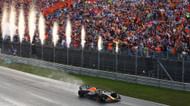As Formula 1 expands into newer markets, Max Verstappen has drawn a line between the heritage circuits that define the sport and the flashy additions that continue to emerge. The reigning world champion advocated for a select group of venues that should hold a permanent spot on the F1 calendar.
Speaking to Formule1 Magazine ahead of this weekend's Austrian Grand Prix, Verstappen pointed out six tracks that should remain a fixture, regardless of global commercial shifts:
"Circuits that, in my opinion, deserve a separate status and always belong on the calendar, purely on sporting grounds, are Spa-Francorchamps, Zandvoort, Silverstone, Imola, Suzuka and Brazil."Most of these old-school tracks have narrow width and limited runoff space, with flowing sequences that prioritize driver skill over aerodynamics.
Max Verstappen also suggested that today's overcrowded calendar is pushing quantity over quality. He added:
"If it were up to me, the calendar would look very different and also have fewer races."In contrast, modern additions since the 2000s, like Jeddah or Yas Marina, follow a more uniform template. They usually have wider asphalt run‑offs with low‑speed sequences, tight chicanes, and are DRS‑heavy.
Max's strength lies in his shared DNA with the tracks on his 'list', which tests both machine and man. However, F1 has varied contracts for these tracks. Spa-Francorchamps will operate on a rotation with other European venues, skipping 2028 and 2030 until 2031. Suzuka is also locked until 2029 and remains a vital stop given Honda's influence and the challenge of its figure-eight layout.
 Max Verstappen (1) passes fireworks during the F1 Grand Prix of the Netherlands at Circuit Zandvoort. Source: Getty
Max Verstappen (1) passes fireworks during the F1 Grand Prix of the Netherlands at Circuit Zandvoort. Source: GettyInterlagos, with its elevation changes and Senna legacy, also holds a deal through 2030. Meanwhile, F1 has its longest commitment with Silverstone, the birthplace of the World Championship, which will hold a race until 2034. But others are in a more precarious spot.
Zandvoort, Verstappen's home GP, is scheduled for its last race in 2026 unless new negotiations succeed. Imola, having returned during the pandemic, will see its deal run out this year with no extension announced as of yet. Despite the emotional weight and racing purity these tracks carry, they are competing for calendar space against high-paying venues in Las Vegas, Saudi Arabia, and Qatar.
Penalty pressure mounts as Max Verstappen looks to Austria for redemption
 Max Verstappen celebrates in parc ferme after the F1 Grand Prix of Austria at Red Bull Ring - Source: Getty
Max Verstappen celebrates in parc ferme after the F1 Grand Prix of Austria at Red Bull Ring - Source: GettyMax Verstappen returns to one of his most successful hunting grounds for the 11th race of the 2025 Formula 1 season. The Austrian Grand Prix is a 71-lap race held over the 4.318 km Spielberg circuit. He has won a record four times here in the last seven editions and is chasing vital points this weekend.
Verstappen currently trails the McLaren duo of Oscar Piastri (198) and Lando Norris (176) at third with 155 points. But there's disciplinary pressure, too. Verstappen is driving with nine penalty points on his FIA super licence, one away from a race suspension. That shadow has loomed since Monaco, but the stakes drop slightly after Sunday.
The two points he earned during a collision with Norris at this very race last year will expire after June 30, offering some breathing space starting Monday. Still, one misstep in Austria could mean Verstappen gets grounded for Silverstone. A clean result at the Red Bull Ring, both competitively and disciplinary, could help the Dutchman reset his campaign.
The Red Bull Ring is a sprint through alpine scenery and overtaking zones. The track features three DRS zones, a deceptively tricky Turn 1-3 uphill sequence, and high-speed corners like Turns 6 and 9 where driver commitment makes all the difference. In the hybrid era, the track has emerged as one of Verstappen's personal strongholds, and he'll need every bit of that edge.
Max Verstappen will also be easy to spot this weekend due to his new special edition Orange Lion helmet, designed for the Austria-Belgium-Zandvoort stretch.
Why did you not like this content?
- Clickbait / Misleading
- Factually Incorrect
- Hateful or Abusive
- Baseless Opinion
- Too Many Ads
- Other
Was this article helpful?
Thank You for feedback
About the author
Edited by Riddhiman Sarkar

.jpg) 6 hours ago
1
6 hours ago
1

 English (US)
English (US)